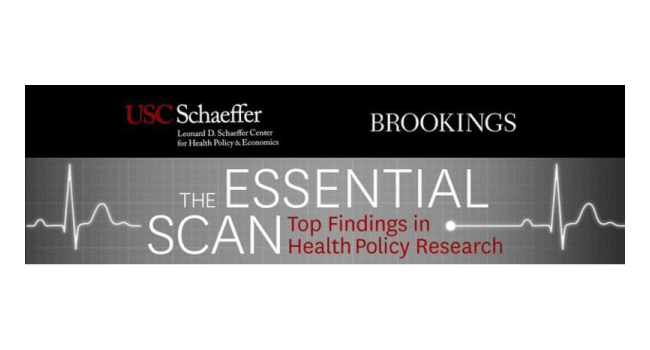What’s the latest in health policy research? The Essential Scan, produced by the Schaeffer Initiative for Health Policy, aims to help keep you informed on the latest research and what it means for policymakers. To sign up to receive the Essential Scan straight to your inbox, sign up here.
Provider Charges Relative to Medicare Rates, 2012-2017
Study by: Loren Adler, Sobin Lee, Kathleen Hannick, and Erin Duffy
Patients can be hit with surprise bills when they are treated by a provider outside of their insurer’s network, especially in a situation where they have no choice, such as in an emergency. In these instances, the insurance company typically only pays a portion of the bill, leaving the patient to make up the difference between what the provider charges and what the insurer is willing to pay. A new analysis examines CMS data on provider charges and compares them to Medicare payment rates for the same services. Researchers found that specialties with the greatest ability to surprise bill out-of-network patients – emergency and ancillary physicians – have significantly higher charges relative to Medicare rates than other specialties. For the two specialties most commonly associated with surprise billing – emergency medicine and anesthesiology – average annual charges relative to Medicare payment rates have grown 6.7 percent and 4.4 percent, respectively. This is compared to the 1.6 percent average annual growth rate in charges to the Medicare rates ratio across all other specialties. This evidence bolsters the urgency of the case for policy solutions to address surprise billing. Full analysis here.
“These data provide strong evidence for the market failure that is the basis of the surprise billing issue and that the problem is getting worse rapidly. Policymakers need to act quickly.”
Paul Ginsburg, PhD
Director, USC-Brookings Schaeffer Initiative for Health Policy
Higher All-Cause Mortality Rates in Rural Areas Linked to Socioeconomic Status, Physician Shortages, and Lack of Health Insurance
Study by: Gordon Gong, Scott G. Phillips, Catherine Hudson, Debra Curti, and Billy U. Philips
Over the past three decades all-cause mortality rates have been higher and life expectancy has been lower in rural areas of the U.S., and the gap between rural and urban areas has widened. While this pattern exists across the U.S., states differ markedly in several aspects – including economic development, infrastructure, socioeconomic factors, race/ethnic composition, and healthcare policies – all of which play a role in mortality and life expectancy trends. A new study looks at whether this pattern might be attributed to health policies, health infrastructure, or socioeconomic conditions. The researchers find rural mortality exceeded urban mortality in all but three states- Montana, Wyoming, and Colorado. Virginia, Florida, and California had the largest rural-urban differences. Rural and urban mortality rates differed across states by as much as 69 percent, suggesting state policy and environment play important roles. The researchers point to three factors to explain higher rural mortality at the state level: an economically poor population, physician shortages, and lack of health insurance. “Efforts to address rural-urban disparities in mortality should focus on improving socioeconomic conditions and on increasing physician supply and health insurance coverage in rural communities,” write the authors. Full study here.
How Political Behavior Helps Explain Where the ACA Works, and Where it Doesn’t
Study by: Samuel Trachtman
The Affordable Care Act passed in 2010 without a single Republican vote in either chamber. Since its implementation in 2014 Republicans have been less likely than Democrats to enroll in insurance through the ACA marketplaces, and instead either go uninsured or purchase “off marketplace” plans. At the population level, high levels of participation in an insurance market are associated with lower premiums, on average. If a high share of the population in a region chooses not to participate, premiums may increase for those who do enroll. A new study examines the association between county-level Republican vote share and growth in ACA marketplace premiums. The researcher found that insurers have increased marketplace premiums at higher rates in areas with more Republican voters, suggesting a lower participation rate in the marketplaces in those areas. A 10-point difference in Republican vote share was associated with a 3.2 percentage point difference in average premium growth from 2014 to 2017. This study suggests that political polarization can have public policy implications, especially for policies that rely on high levels of active participation in geographic areas where they are unpopular. The author also notes that these findings suggest the scope of policy effects may be limited due to a self-fulfilling prophecy wherein policies perform worse in areas where they lack political support. Full study here.
Rural Hospital Affiliation with Large Health Systems Associated with Improved Financial Performance but Potentially Reduced Local Access to Some Services
Study by: Claire E. O’Hanlon, Ashley M. Kranz, Maria DeYoreo, Ammarah Mahmud, Cheryl L. Damberg, and Justin Timbie
Across the U.S., individuals in rural areas often lack access to high-quality healthcare services, which has been exacerbated by hospital closings in rural areas. Many rural hospitals, in order to stay open and improve their financial performance, have opted to affiliate with large health systems. In recent years, mergers and acquisitions among rural hospitals have increased, but the effects of affiliation on rural hospital performance are largely unknown. A new study focuses on the performance of rural hospitals that affiliated with health systems between 2008 and 2017. While the researchers found the affiliation was associated with improved financial performance, there was also a reduction in local access to certain services, including on-site imaging, obstetric services, and primary care departments. “Given the potentially negative consequences of affiliation, policymakers should support mechanisms that help rural hospitals remain financially viable without it,” write the authors. Full study here.
Click here to receive The Essential Scan email.
The Essential Scan is produced by the USC-Brookings Schaeffer Initiative for Health Policy, a collaboration between the Brookings Institution and the USC Schaeffer Center for Health Policy & Economics.
